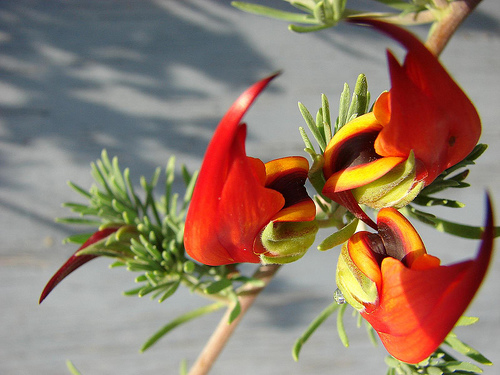Parrot’s beaks are delicate bursts of vivid colour.
- Parrot’s beaks are a species of perennial flowering plant, native solely to the Canary Islands, located off the north-west coast of Africa.
- The scientific name of the parrot’s beak plant is Lotus berthelotii and it is from the family Fabaceae, the family of legumes.
- The blooms of parrot’s beaks are red to orange coloured and resemble the beak of a parrot.
- ‘Parrot’s beaks’ are also known as ‘coral gems’, ‘pelican’s beaks’, ‘lotus vines’, ‘cat claws’, and ‘pigeon beaks’ or by the Spanish for the same name – ‘pico de paloma’.
- A parrot’s beak plant will generally grow to a height of 15 to 30 centimetres (6 to 12 inches), and it is a creeper, so it tends to spread to a diameter of approximately 61 cm (24 inches) if grown on the ground.
Parrot’s Beak
Image courtesy of Emma Forsberg/Flickr
- Parrot’s beaks typically bloom during the late spring and early summer months.
- Parrot’s beaks grow best in conditions of full sun, and while they can be grown in part shade, they will usually not produce as many flowers.
- The leaves of parrot’s beaks are small and very narrow, and are a green-grey in colour.
- Parrot’s beaks are fittingly pollinated by birds, and are extremely rare or extinct in the wild.
- The parrot’s beak plant is typically grown for ornamental purposes, especially as a ground cover or carpet, and it is also grown in hanging baskets or pots.
Bibliography:
Lotus berthelotii, 2016, Wikipedia, https://en.wikipedia.org/wiki/Lotus_berthelotii
Parrot’s Beak, 2016, Better Homes & Gardens, http://www.bhg.com/gardening/plant-dictionary/annual/parrots-beak/
Parrot’s Beak, Coral Gem, Pelican’s Beak, 2016, Dave’s Garden, http://davesgarden.com/guides/pf/go/1250/#b
Plant Profiles: Lotus Berthelotii, 2013, Garden at Heart, http://gardenatheart.blogspot.com.au/2013/03/plant-profiles-lotus-berthelotii.html







